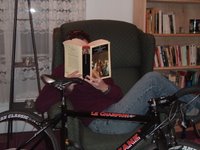In a way, I'm hesitant to talk about Virginia Woolf's "Kew Gardens" as a story, since it shares so little with other short stories I'm familiar with. In what sense is this a story? In a lot of ways, it seems more accurate to call it a sketch, or maybe a prose poem. It consists of a description of a flower bed in Kew Gardens and a snail slowly making its way between the plants and around the leaves. It describes the colors and the light in minute details. We read of small groups of people who walk by the flower bed; we catch little bits of their conversations, enough to begin to piece together a story, but really only fragments before they move on and we lose sight of them.
What tempts me to call the work a prose poem is not so much the beautiful description, although there is plenty of that, but more the way it creates a mood, the people and the natural world together, so that the point is not what happens but how we feel as we read it. I'm also tempted to call it a prose poem because it gives us little glimpses of stories that we have to work to put together, in the way a poem will sometimes hint at a situation without fleshing it out, and focus on the feeling of that situation more than the events, even though the events are often implicit.
What we get from the vignettes are images, as we might find in poems, as when the first man thinks of 15 years previously when he sat in the gardens with Lily and asked her to marry him and she refused:
We sat somewhere over there by a lake and I begged her to marry me all through the hot afternoon. How the dragonfly kept circling round us: how clearly I see the dragonfly and her shoe with the square silver buckle at the toe. All the time I spoke I saw her shoe and when it moved impatiently I knew without looking up what she was going to say: the whole of her seemed to be in her shoe.
We picture the man staring at the Lily's shoe and watching its impatient movements and understanding his fate, and we also picture that same man 15 year later walking through the gardens with his wife and children and remembering Lily's rejection with relief and with regret.
We see an old man walking with a younger one:
He talks incessantly to the younger man about spirits who are speaking to him of heaven, and the younger man's "look of stoical patience [grows] slowly deeper and deeper." With the older man's jerky movements and the younger man's strained calm, we put together the story of failing mental powers on the one hand and youthful health and energy on the other. Woolf gives these hints of story through the images themselves; they are vibrant because they are brief and sharply focused.The elder man had a curiously uneven and shaky method of walking, jerking his hand forward and throwing up his head abruptly, rather in the manner of an impatient carriage horse tired of waiting outside a house; but in the man these gestures were irresolute and pointless.
Woolf spends as much time describing the flower bed and the snail as she does the people; in fact, since there are four groups of people who walk by, the snail gets much more attention than any particular person does. The human stories are not privileged; the snail's decision whether to crawl around or over or under the leaf is just as important as whether Lily said yes or no. With Woolf's careful description of the flowers and the sunlight, she creates a feeling that the natural world, even though it is made up of individual parts that are fleeting, as a whole is more real and long-lasting than the human world.



|